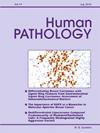Chimeric antigen receptor (CAR) T-cell therapy-related gastrointestinal toxicity: Histologic features and morphologic mimics
IF 2.7
2区 医学
Q2 PATHOLOGY
引用次数: 0
Abstract
Chimeric antigen receptor (CAR) T-cell therapy is a contemporary treatment modality for hematologic malignancies, with potential future applications in solid tumors. While the clinical side effects of CAR T-cell therapy are well-documented, histologic correlations of gastrointestinal (GI) toxicity remain underreported. This study prospectively identified 5 sets of GI biopsies from 3 patients presenting with CAR T-cell therapy-associated GI toxicity. Patients exhibited symptoms such as abdominal pain, hematochezia, non-bloody diarrhea, weight loss, and fever/chills, occurring 1.5–8 months post-therapy. Histologic examination revealed a graft versus host disease (GVHD)-like pattern of injury in colon biopsies, characterized by epithelial apoptosis, crypt dropout, and neuroendocrine cell nests. One duodenal biopsy showed intraepithelial lymphocytosis and villous blunting, mimicking celiac disease. A notable paucity of CD20-positive B-cells and CD38-positive plasma cells was observed in both colonic and small intestinal biopsies. Two patients required biologic agents for treatment, while one patient improved with corticosteroids but succumbed to an upper respiratory infection. The findings underscore the necessity of correlating symptom onset with therapy timing to achieve accurate diagnosis of CAR T-cell therapy-associated GI toxicity.
嵌合抗原受体(CAR) t细胞治疗相关的胃肠道毒性:组织学特征和形态模拟
嵌合抗原受体(CAR) t细胞疗法是血液系统恶性肿瘤的一种当代治疗方式,在实体肿瘤中具有潜在的应用前景。虽然CAR - t细胞治疗的临床副作用已被充分证明,但胃肠道(GI)毒性的组织学相关性仍未得到充分报道。本研究前瞻性地确定了来自3例CAR - t细胞治疗相关胃肠道毒性患者的5组胃肠道活检。患者在治疗后1.5-8个月出现腹痛、便血、无血性腹泻、体重减轻、发热/寒战等症状。组织学检查在结肠活检中发现移植物抗宿主病(GVHD)样损伤模式,其特征是上皮细胞凋亡、隐窝脱落和神经内分泌细胞巢。一次十二指肠活检显示上皮内淋巴细胞增多和绒毛变钝,类似乳糜泻。结肠和小肠活检均发现cd20阳性b细胞和cd38阳性浆细胞明显缺乏。两名患者需要生物制剂治疗,而一名患者使用皮质类固醇改善,但死于上呼吸道感染。研究结果强调了将症状发作与治疗时间联系起来的必要性,以便准确诊断CAR - t细胞治疗相关的胃肠道毒性。
本文章由计算机程序翻译,如有差异,请以英文原文为准。
求助全文
约1分钟内获得全文
求助全文
来源期刊

Human pathology
医学-病理学
CiteScore
5.30
自引率
6.10%
发文量
206
审稿时长
21 days
期刊介绍:
Human Pathology is designed to bring information of clinicopathologic significance to human disease to the laboratory and clinical physician. It presents information drawn from morphologic and clinical laboratory studies with direct relevance to the understanding of human diseases. Papers published concern morphologic and clinicopathologic observations, reviews of diseases, analyses of problems in pathology, significant collections of case material and advances in concepts or techniques of value in the analysis and diagnosis of disease. Theoretical and experimental pathology and molecular biology pertinent to human disease are included. This critical journal is well illustrated with exceptional reproductions of photomicrographs and microscopic anatomy.
 求助内容:
求助内容: 应助结果提醒方式:
应助结果提醒方式:


